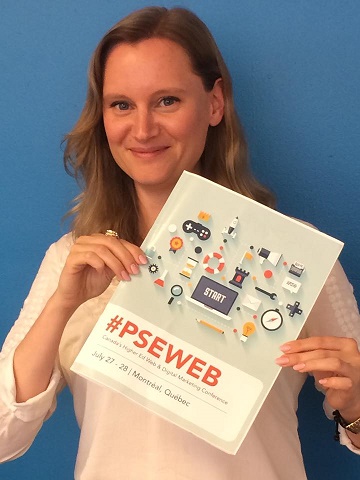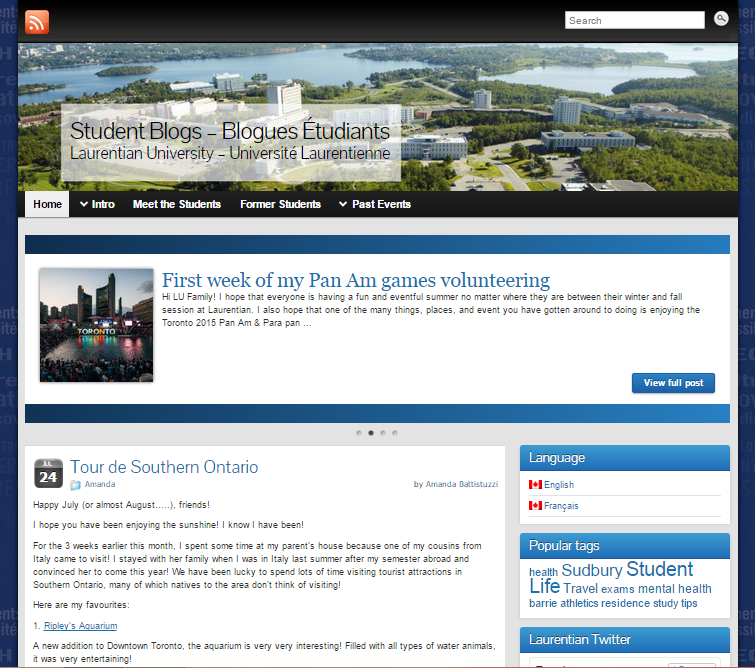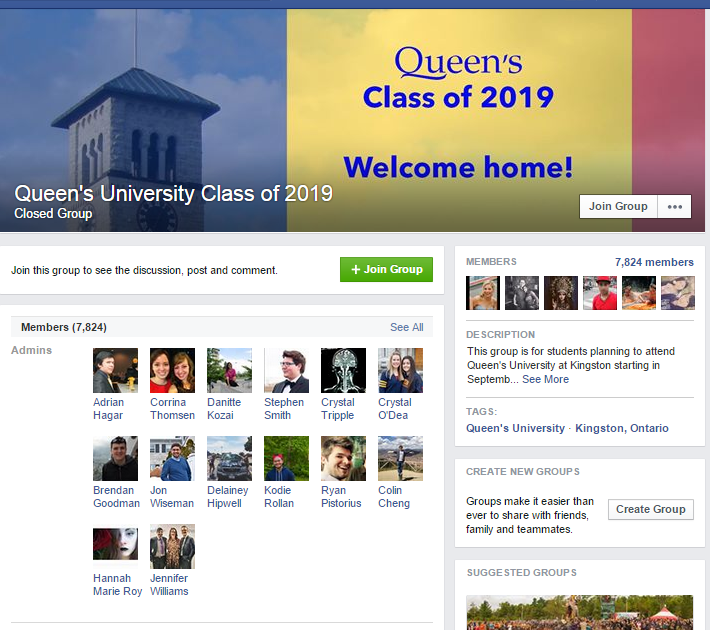
In his opening keynote speech, higher ed expert Ken Steele (Eduvation) set the tone for PSEWEB 2015 by highlighting some of the latest “augmented reality” trends in education marketing.
Campus tours shot by drones. Promotional videos of class lectures via Google Glass. The movement toward “un-bundling” courses into smaller learning modules (we’ll examine this one more closely in an upcoming post).
It’s all about offering insider access, capturing and sharing genuine student experiences, and meeting applicants on their own terms.
It’s a bigger, more impactful – and yet in many cases more personalized – world of inbound marketing for education institutions.
I mean, it doesn’t get much more “augmented” than this drone-powered campus tour, which grants viewers instant, gravity-defying, multi-angle views of the university and its grounds. It’s almost better than being there in person!
Read on to discover how PSEWEB’s participating Canadian (and American – we haven’t forgotten you, Penn State!) institutions are responding to students’ demand for more: more access, more customization, and more authentic engagement both on and offline.
1. Student Ambassadors as Content Producers & Publishers
Several PSEWEB presenters, Angi Roberts of U of Guelph in particular, emphasized students’ growing disdain and disregard for the “institutional” voice in social media marketing.
They are often content-blind to material that, no matter how artfully created, seems a few too many steps removed from their own peer group. As Angi reminded us, we might be excellent admissions and recruitment professionals – but none of us are 18 year-old students. And none of us has access to the kinds of social events, situations, and experiences that our students engage in on a daily basis.
In order to offer more authentic content, several universities have formed teams of student ambassadors to regularly create and publish posts, videos, blogs, photos, etc. And the subject of at least three talks was the advantages of the student-led approach and how best to manage the ambassador teams. Here are the highlights.
Recruiting Student Ambassadors
When forming his student content team, Antoine Ste-Marie (Laurentian University) began by defining personas – archetypes that represent his institution’s most prevalent target audiences. Next, he seeks out creative kids who are already involved with writing, music and other form of creative production, and selects ambassadors who fit the profiles he’s established.
The approach is strategic (ensuring target audiences are represented), while ensuring ambassadors are already familiar with reaching out to their peers with a range of media.
Here’s a look at Laurentian’s student blog:

Other presenters said they recruit students who are already collaborating with admissions – perhaps by giving campus tours. Candidates are screened by way of a questionnaire that gauges how much time they’d have to offer, what campus activities they’re involved in, and how savvy they are with social media.
Managing Student-Created Content
Some of you may be wondering just how much autonomy student ambassadors should have when it comes to developing and publishing their own content.
Angi Roberts began by previewing each of her ambassador’s social media posts before they went live, but over time has become comfortable enough to check the content after it’s been published.
Students adhere to a predetermined schedule, manage their own responsibilities, and simply send Angi a text once they’ve posted their content. With the help of student ambassadors, the University of Guelph has even extended its recruitment reach into China, in Mandarin, on a platform called Weibo.
When it comes to longer-form content like blogs, both Ryerson and Laurentian Universities play a more prominent role in the editing process.
Tesni Ellis (Ryerson U) meets regularly with her team of student ambassador bloggers to discuss their work, make suggestions for improvement, and foster their development as writers and critical thinkers.
Takeaway:
Schools must find their own balance between supervision and student autonomy so that content remains on-brand without compromising a fresh, timely, and authentic feel.
Forming and managing teams of student ambassadors doesn’t have to be complicated. But it’s clear that structural elements like a screening process, well-defined code of conduct, and some degree of supervision are crucial for this approach to work.
2. Thinking Outside the Box to get the Inside Track: Creative Content Ideas
PSEWEB reminded us that education marketers can and should seek inspiration from outside the post-secondary marketplace. Drawing on trends and techniques from other industries can help keep us current while tapping into what prospective students are doing, thinking, and focussed on.
Lindsay Fair (Queens University, Arts and Sciences) created a buzz at PSEWEB when she shared her creative approach to connecting with students on social media.
Leveraging her background in advertising, Lindsay continuously tracks what Queens social media community members are talking about most (looking at popular hashtags and Facebook conversations), sifting out keywords and phrases that appear with a high frequency each day.
She then posts content that responds directly to those topics, pre-emptively solving problems, answering common questions, or responding to trending interests.
Here’s an example of a word cluster she developed based on her tracking methodology, with high-frequency words circled in red:
 source
sourceBased on her analysis, Lindsey discovered that there was a lot of negative sentiment around the bus commute from west campus to main campus, so she quickly created and shared this 2-minute video that shows just how quick and easy the commute really is, stopping negative chatter in its tracks while providing genuinely useful information to incoming students.

In another instance, Lindsey noticed recurring mentions of the term “bird course” on social channels, signaling that students were seeking insider tips on which courses were the easiest to ace.
In response, Lindsey posted this tongue-in-cheek response on Facebook that she knew would catch followers’ attention (they are quite literally courses about birds):

Takeaway:
What is key about Lindsey’s ingenious approach to personalized content is its timeliness. There is very little turnaround time between recognizing a trend and posting a responding piece of content – at the most six hours!
This is quite a departure for admissions and marketing teams who prefer to plan and prep content days or weeks in advance – but definitely an approach worth considering for tapping into and keeping up with students’ quick-changing interests.
Comic Book Re-Brand
Portage College also created a stir with an innovative content strategy that draws on the widespread influence on comic books in pop culture and advertising.
Presenter Andrew Whitson said he came up with the idea when the college was compelled to re-brand for a younger target audience. Portage was firmly entrenched in the community’s consciousness as an institution for older students, so Andrew knew they needed something really unique to successfully pull off such a radical shift in identity.
In the true spirit of inbound, Andrew decided to use creative storytelling to change the conversation about Portage. Using comic characters based on typical Portage students (personas) and a narrative designed to engage, not sell, Andrew has gained impressive traction with this high-quality print series called Modern Voyageur. Here’s a peak at a page:

Students can follow the main character on Twitter (he has his own account) and check online for story updates once a week as new pages are released on the Modern Voyageur website and across social media.
What’s next? More authentic engagement as Portage students come on board to suggest storylines and even write themselves into the narrative. Talk about augmented reality! Who doesn’t want to be a comic-book character?
3. Reigning in the Rogue Content Creator: Unauthorized Social Media Accounts
With all of this excitement about including students in the content creation process, it was wise for Nicolle Wahl (U of Toronto, Mississauga) and Stephen Martone (Stressed Out Solutions) to raise a red flag about unauthorized social media accounts.
What happens when students go too far, and appropriate the institution’s brand to engage in questionable, distinctly off-brand activities on platforms like Facebook?
Good question. Although Stephen gave us some compelling insights into how to research and expose university “imitator” profiles and their promulgators, it was clear from Nicolle’s talk that the law is not always on our side when it comes to confronting them – and shutting them down.
Using examples from her own institution, Nicole chronicled her own battle against unofficial social media accounts – for example, “Class of _____” pages that use the U of Toronto logo but are not sanctioned by the university.
Here is an example of a student-created account. It uses the university’s branding to appear official, so most visitors would never know that the institution did not in fact create the page. This particular account has been deemed harmless by Queens, but it gives a good sense of how convincing imitator profiles can be:

Undesirable accounts often link to websites the institution would rather not be associated with. Plus, conduct on the account may be less than becoming.
Students who miss-read the profile as official give away private information, like their residence room number and class schedule, in response to offers to “make new friends.” The school’s reputation and the safety of its students is at risk.
What did Nicolle do to combat U of Toronto’s undesirable Facebook account? She went through official channels, looking up Facebook’s rules about using a trademark or logo without permission and the university’s policy on student-led accounts. But in the end, she (with Stephen’s sleuthing expertise) had to track down and contact the account administrator herself and strong-arm him into shutting down the Facebook page.
Takeaways:
1. Ensure your admissions and recruitment team regularly monitors social channels for imposter accounts with inappropriate content, and has a strategy in place for confronting them.
2. Develop a detailed social media policy so well-wishing students who create pages for their graduating class understand the guidelines for appropriate conduct, and the penalties for breaching those guidelines.
3. Add a social media hub to your school’s website with links to institution-approved, student-led accounts that you know are safe to join (these groups are great and should be encouraged!).
4. Map it and Track it: Understanding and Measuring the Student Experience
It’s no surprise that PSEWEB’s intense focus on generating authentic, student-driven content led naturally to discussions about how to measure and track resultant engagement. And how to understand what students are really going through during application (and afterward) in order to target communications and campaigns even more effectively.
We saw many audience members raise their hands to ask how a particular content strategy impacted intake numbers. Or how schools were tracking results to refine the next stage of their content strategy and development.
The emphasis on data-driven education marketing is growing – and an increasing number of admissions and recruitment teams are becoming proficient in Google Analytics.
In her inspiring talk on GA, Karine Joly (Higher Ed Experts) reminded us that following education marketing trends alone is not enough to optimize connections with target audiences. Schools must look at their specific data to learn more about student behaviour at various stages of the recruitment process – and this need not be an overwhelming process!

Diffusing anxiety around the sheer number and complexity of tools and reports available on GA, Karine offered this wise takeaway to anyone new to the world of analytics:
Focus on three to five metrics that measure your clearly defined goals. Only measure what matters (for example, bounce rates and goal completion) to avoid getting lost down the data rabbit hole.
Student Journey Mapping to Optimize User Experience
With his talk on user journey mapping in higher ed, JP Rains (Soshal) reminded us that tracking students’ behavior through the recruitment process is an essential part of creating content that resonates authentically with their interests and needs.
Together with Google Analytics, student journey mapping is an excellent way to develop a tactical understanding of how applicants are interacting with your website, social media channels and admissions team. What are the most common touchpoints? Painpoints? Where are conversions being lost to competitors? Where is more nurturing needed?
Here’s a simple example of step one, which is to identify touchpoints for each persona:

Understanding how students experience each touchpoint helps guide and target the kinds of creative content solutions we loved hearing about at PSEWEB.
Final takeaway:
Creativity + Technical Expertise = Augmented Engagement!
What do you think is the greatest challenge in connecting with prospective students in ways that are both authentic and strategic?
Resources:
Click here for an introduction to Student Journey Mapping
Click here for additional information about PSEWEB presenters and to access their Power Point presentations






